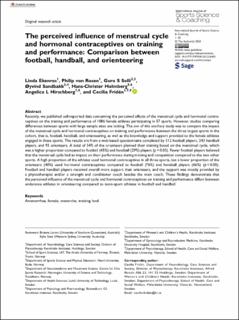| dc.contributor.author | Ekenros, Linda | |
| dc.contributor.author | von Rosen, Philip | |
| dc.contributor.author | Solli, Guro Strøm | |
| dc.contributor.author | Sandbakk, Øyvind Bucher | |
| dc.contributor.author | Holmberg, Hans-Christer | |
| dc.contributor.author | Hirschberg, Angelica L | |
| dc.contributor.author | Fridén, Cecilia | |
| dc.date.accessioned | 2024-01-30T08:22:58Z | |
| dc.date.available | 2024-01-30T08:22:58Z | |
| dc.date.created | 2024-01-02T11:06:58Z | |
| dc.date.issued | 2023 | |
| dc.identifier.citation | International journal of sports science & coaching. 2023, . | en_US |
| dc.identifier.issn | 1747-9541 | |
| dc.identifier.uri | https://hdl.handle.net/11250/3114420 | |
| dc.description.abstract | Recently, we published self-reported data concerning the perceived effects of the menstrual cycle and hormonal contraceptives on the training and performance of 1086 female athletes participating in 57 sports. However, studies comparing differences between sports with large sample sizes are lacking. The aim of this ancillary study was to compare the impact of the menstrual cycle and hormonal contraceptives on training and performance between the three largest sports in the cohort, that is, football, handball, and orienteering, as well as the knowledge and support provided to the female athletes engaged in these sports. The results are from a web-based questionnaire completed by 312 football players, 243 handball players, and 93 orienteers. A total of 54% of the orienteers planned their training based on the menstrual cycle, which was a higher proportion compared to football (45%) and handball (29%) players (p < 0.05). Fewer football players believed that the menstrual cycle had an impact on their performance during training and competition compared to the two other sports. A high proportion of the athletes used hormonal contraceptives in all three sports, but a lower proportion of the orienteers (40%) used hormonal contraceptives compared to football (76%) and handball players (66%) (p < 0.05). Football and handball players received overall more support than orienteers, and the support was mostly provided by a physiotherapist and/or a strength and conditioner coach besides the main coach. These findings demonstrate that the perceived influence of the menstrual cycle and hormonal contraceptives on training and performance differs between endurance athletes in orienteering compared to team-sport athletes in football and handball. | en_US |
| dc.language.iso | eng | en_US |
| dc.publisher | SAGE | en_US |
| dc.rights | Navngivelse 4.0 Internasjonal | * |
| dc.rights.uri | http://creativecommons.org/licenses/by/4.0/deed.no | * |
| dc.title | The perceived influence of menstrual cycle and hormonal contraceptives on training and performance: Comparison between football, handball, and orienteering | en_US |
| dc.title.alternative | The perceived influence of menstrual cycle and hormonal contraceptives on training and performance: Comparison between football, handball, and orienteering | en_US |
| dc.type | Journal article | en_US |
| dc.type | Peer reviewed | en_US |
| dc.description.version | publishedVersion | en_US |
| dc.source.journal | International journal of sports science & coaching | en_US |
| dc.identifier.doi | 10.1177/17479541231216403 | |
| dc.identifier.cristin | 2218747 | |
| cristin.ispublished | true | |
| cristin.fulltext | original | |
| cristin.qualitycode | 1 | |

